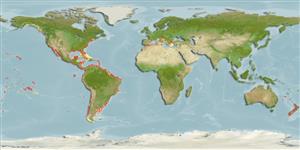Common names from other countries
Classification / Names / Names
Common names | Synonyms | Catalog of Fishes (gen., sp.) | ITIS | CoL | WoRMS
Environment: milieu / climate zone / depth range / distribution range
Ecology
Benthic; depth range 0 - 40 m (Ref. 87801). Subtropical
Eastern Pacific, Western Atlantic and the Mediterranean.
Length at first maturity / Size / Weight / Age
Maturity: Lm ? range ? - ? cm
Trunk segmentation complete between first and second segments, incomplete between posterior 2 segments. Neck fairly long. Ocular tubercle long, carried obliquely anteriorly, with slender apical tubercle shorter than ocular tubercle diameter; eyes distal, well pigmented. Lateral processes separated by their diameter or slightly less, anterior pair longest, lengths decreasing posteriorly, each with tiny, low dorsodistal tubercle with seta (Ref. 2115, p. 43).
Minimum depth from Ref. 83931. A benthic species found in intertidal and subtidal areas (Ref. 83931). Coastal to shelf (Ref. 19); littoral, shallow (Ref. 2115, page 43). Epibiotic (Ref. 1161112).
Life cycle and mating behavior
Maturity | Reproduction | Spawning | Eggs | Fecundity | Larvae
Members of the class Pycnogonida are gonochoric and sexually dimorphic. During copulation, male usually suspends itself beneath the female. Fertilization occurs as the eggs leave the female's ovigers. Males brood the egg masses until they hatch. Life cycle: Eggs hatch into protonymphon larva then to adults.
Bamber, R.N. and Y. Takahashi. 2005. (Ref. 1853)
IUCN Red List Status (Ref. 130435)
CITES status (Ref. 108899)
Not Evaluated
Not Evaluated
Human uses
| FishSource |
Tools
More information
Age/SizeGrowthLength-weightLength-lengthMorphologyLarvaeAbundance
Internet sources
Estimates based on models
Preferred temperature
(Ref.
115969): 12.1 - 28, mean 24.1 (based on 506 cells).
Price category
Unknown.
